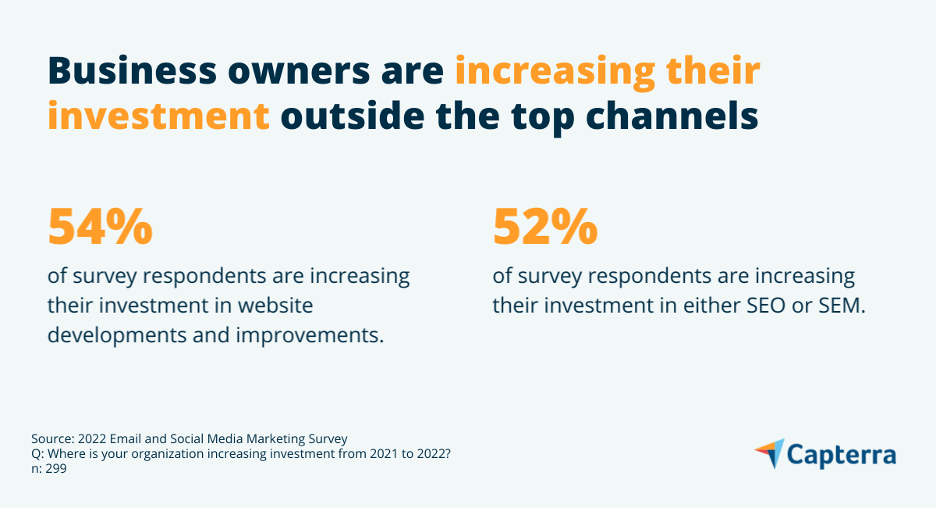These insights from fellow SMBs will help kick your strategy into high gear.
Even if you’re experienced, it’s difficult keeping up with the pace of change in the world of online marketing strategy. If you’re new? It can be downright daunting to select the right channels, tools, and tactics.
In Capterra’s 2022 Email and Social Media Marketing Survey [*], we asked business owners about their marketing activities in an effort to understand how they make these decisions effectively so we can help you do the same.
Here we’ll share findings from the survey along with illuminating insights from real small-business owners (SMBs) on how they navigated crafting their own digital marketing strategy.
What makes for a successful online marketing strategy?
A successful online marketing strategy is a plan for how to utilize paid, owned, and earned media through digital marketing channels to connect with your target audience and accomplish business goals while continuously improving the strategy and striving to increase return on investment (ROI). The most successful strategies generally put the customer experience at the forefront and judiciously preserve resources by utilizing only the most effective tactics.

The tips we’ll be sharing come from small business owners Diego Kafie, co-founder and CEO of the mobile arcade platform Playbite[1] and Matt Addison, co-founder of the athleisure brand Rugged Black[2].
They both had a lot to share about their businesses’ successes in establishing an effective small business marketing engine, and we’re here to relay those insights to you. Before we do that, however, we’ll share two key survey findings and what they mean for you as a small business owner.
Finding #1: Social media and email marketing are tied as the most used marketing activities, but SEO is becoming extremely critical

It may come as no surprise that 100% of survey respondents use both social media and email marketing [*]. However, the lockstep observed between content marketing, SEO, and creative asset production is especially notable. Take it from Matt and Diego who both discussed content marketing as integral to their overall strategies when coupled with strong SEO tactics and video content creation.
When asked about the most critical marketing channel to Rugged Black’s success, Matt said, “The epiphany was using content marketing targeting long tail keywords and less competitive spaces to produce sustainable traffic and thousands in revenue,” compared to traditional paid ads that don’t offer nearly the same return on investment.
Diego also notes the harmony between content marketing and SEO, citing the volume of articles Playbite is producing weekly to bolster its SEO strategy. In fact, 78% of survey respondents find that SEO is critical to their marketing strategies, with nearly half of that group saying it’s extremely critical [*].
Narrow your search for digital marketing agencies with our list of companies in the following areas:
Finding #2: Businesses are increasing their marketing investment in more areas than you may think

Not only are SMBs using search engine marketing more, but they’re also increasing their investment in this digital marketing tactic along with improvements to their websites. In fact, over half of all businesses are increasing their spending in both website development and SEO. Why is this?
According to Matt, it’s due to the ability to truly own your content. As he puts it, “Owned media and an owned audience is key.” Content marketing, creative assets like video, and website content all go hand in hand to make this type of owned media strategy a reality.
As a small business, there’s only so much you can control, and that list includes what a prospective customer finds on your website and the content you’re able to write and promote through SEO.
Tips to increase the effectiveness of your small business’ online marketing
Tip #1: Get to know your audience
Understanding the needs of your customers is one of the holy grails of online marketing. Aside from basic info (e.g., age, location, income, etc.) you’ll also want to discover other aspects of your ideal prospective customer such as their interests, motivation factors, and where they spend their time online.
Use this info to construct buyer personas that act as detailed audience profiles. Use survey data from existing customers, reviews of your business, and what people are saying about your industry online to construct a profile that you can then use to guide your marketing. But, be open to change.
As a brand trying to reach young, Black, urban males, Matt was surprised when some of his strongest traction came from older demographics as a result of an early morning news segment on the brand—not necessarily social media posts aimed at younger people. Suddenly customers who weren’t originally in the plan became a major source of traction.
Looking to attract new customers on social media? Learn about the 5 Best Social Media Marketing Tips for Small Businesses to leverage your social platforms.
In this example, Matt discovered that “the difference between buyer personas you create and the ones that actually resonate is important to consider.”
Diego relies on Playbite’s community on a popular online chatting platform to get feedback straight from their audience. Not only does Playbite collect valuable customer information, but now their most loyal audience members get to take a front seat to the product’s development. This increases both their investment in the platform and trust in the brand.
Tip #2: Select the appropriate marketing channels
Finding the right marketing channels for your industry, goals, and audience will also have an outsized impact on your marketing results. Focus on one primary and one secondary channel that checks the most boxes. As you discover what your audience responds well to, you can strengthen your initial channels then adapt those learnings to new channels as you expand your marketing efforts.
For example:
If you sell photogenic products and your goal is to increase brand awareness, a visual social media platform like Instagram would work well.
If you provide a service that requires specific expertise or a subject customers seek to learn more about, exploring content marketing and eventually SEM will help you build brand authority and earn more website traffic.
If you’re a brick and mortar retail business hoping to attract and retain customers, mobile and email marketing can help establish regular communication with your target audience in an effort to bring them to your business.
Stumped on which software you should be using for your business? Check out Category Compare: Content Marketing vs Social Media Marketing to get a grasp on these tools.
In Playbite’s case, Diego’s strategy is to explore a channel by focusing his efforts on it for a period of time to see if it can have an outsized impact before committing more time and energy to it. Diego notes that, as a resource-constrained startup, Playbite recognizes the importance of approaching both their product development and their marketing in a very methodical way.
For Matt, he doubles down on the importance of focusing on fully owned channels so as not to be beholden to rapid changes in the way Big Tech platforms work. A strategy that started primarily as paid ads driving traffic to Rugged Black’s website has now morphed into an owned content marketing and video approach that focuses on a direct, long lasting relationship with customers instead of ad dollars spent.
Tip #3: Choose the right tools for your situation
Having the right tools in your martech stack is a huge contributing factor to your overall marketing success. According to Capterra’s 2021 Startup and Small Business and MarTech Survey [**], the following tools are very effective in helping companies achieve their marketing goals:
Social media management: These tools help create and post content, engage with your followers via community management, conduct social listening around your brand, and help manage your reputation online.
Customer relationship management (CRM): A one-stop shop for all things customer experience, these tools help connect the dots between departments and functions within your organization to provide a holistic view of customer communications.
Email marketing: This type of software aids in the creation and management of email campaigns, crafting aesthetically pleasing messages, and tracking key metrics like click-through and open rates.
A/B testing: These tools help businesses make smarter decisions through personalization and optimization of marketing content, allowing them to further segment their audience and customize creative with the goal of increasing conversions.
For Matt, software selection all comes down to where your customers spend their time online. He notes:
“You have to decide who you’re going after and where you congregate. On every marketing channel there’s going to be software that makes your life easier and makes you money.”
Matt Addison
Co-founder, Rugged Black
Before you consider buying a new marketing tool, analyze your current tech stack to avoid purchasing tools with overlapping functionality. You can also identify gaps that new software (or upgrades to current tools) might be able to fill. The key here is to fully understand your existing stack’s functionality, strengths, and weaknesses before you spend time and money on new tools.
/ Start here
A well-rounded CRM platform will likely gain you the most ground. CRMs let you connect the dots between all areas of your business and use marketing automation to help you make smarter, faster decisions to improve the customer experience.
Tip #4: Consider bringing in outside help
Our final tip involves recognizing when it may be a good idea to acquire outside help in the form of a digital marketing agency. Digital agencies aid businesses in a variety of ways ranging from the completion of daily marketing tasks to engaging in long-term planning and strategic thinking.
Diego likens this relationship to the bus (your product) and the bus driver (who carries out the tasks). If you’re focused on building the bus, you still need someone to drive it. And that’s where an agency or freelancers may come in.
Although Playbite in particular relies on automation to reduce the time and energy their full-time employees spend on various tasks, Diego doesn’t rule out the possibility of an agency or freelancers to help stay inside the lanes.
Here’s a brief overview of the pros and cons of hiring a digital agency:
Pros | Cons |
Time and money savings | Potential industry knowledge gaps |
Access to outside expertise | You’re not their only client |
An increase in marketing productivity | There’s an upfront cost |
/ Learn more
There are a lot of things to consider when choosing whether or not to hire outside help, and this list is not exhaustive. If you want to learn more now, refer to our article featuring 4 Key Considerations to Help You Choose a Digital Marketing Agency of your own.
Capterra tools & tips for getting the most out of your marketing efforts
Building an online marketing strategy for a startup or small business from the ground up can feel daunting, but it doesn’t have to be. With the firsthand experience of successful business owners like Matt and Diego, you can feel confident honing your own effective strategy.
Careful consideration of the activities that best suit your business as well as aspects like the needs of your ideal audience, the tools you use to complete marketing objectives, and taking the right approach to in-house vs. outsourced help will all set you up for success.
If you’re excited to keep learning after getting to work on the above, visit the Capterra blog for more marketing resources:
